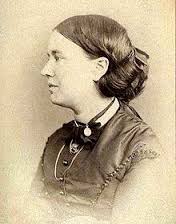 Novel writer and poet Jean Ingelow was born in 1820 in Lincolnshire, the daughter of a local banker, her mother originally from Scotland. Brought up initially in Boston, the family moved during her childhood to Ipswich before finally settling in London where Ingelow would spend most of the rest of her life. Whilst she could never compete with the literary heights of an Elizabeth Barrett Browning, Ingelow was none the less a very lyrical poet and was very popular at the time particularly with the general public both England and America.
Novel writer and poet Jean Ingelow was born in 1820 in Lincolnshire, the daughter of a local banker, her mother originally from Scotland. Brought up initially in Boston, the family moved during her childhood to Ipswich before finally settling in London where Ingelow would spend most of the rest of her life. Whilst she could never compete with the literary heights of an Elizabeth Barrett Browning, Ingelow was none the less a very lyrical poet and was very popular at the time particularly with the general public both England and America.
Ingelow was 30 when she wrote her first work of poetry, A Rhyming Chronicle of Incidents and Feelings, and followed it with a novel a year later, but her first contributions did not make much of a stir at the time. Her first collection of poetry did however attract the attention of Alfred Lord Tennyson and they became lifelong friends after initial correspondence.
Ingelow had begun her career in poetry as a young girl, managing to get verses published in various newspapers and journals at the time. She would often publish under the pen name of Orris or, on occasion, anonymously.
It wasn’t until the publication of her collection Poems in 1863 that Ingelow began to get some more recognition. Critics gave it good reviews and the public began to buy copies on the back of this with poems such as Divided and The High Tide on the Cost of Lincolnshire proving to be favorites.
Her work was influenced by the likes of Wordsworth and, of course, Tennyson and the verses show a range of dramatic insights that were often lacking in some of her contemporaries. The collection even made it across the pond to America where it reputedly sold over 200,000 copies in a very short time.

In 1867, Ingelow worked with fellow poet Dora Greenwell to edit a selection of verses for children under the title The Story of Doom and Other Poems, a collection which proved equally popular. For it, she wrote the title poem, the longest work in the book which explores the age old biblical tale of Noah in free verse.
After her relative success, Ingelow moved away from poetry for a while and began writing novels such as Off the Skelligs and Sarah de Berenger. Influenced by the likes of Lewis Carroll, she wrote a number of stories for children but her popularity as a poet began to fall away. Amongst her stories, the most widely acclaimed was the fable The Prince’s Dream which was first published in The Wonderbox Tales in 1863.

Her most popular poems of the day were verses such as Sailing Beyond Seas which captured the imagination of the public with their lyrical, almost melancholic qualities. She was often dismissed by the critics over the years who would point to her success with her most acclaimed poem Divided and yet often deride her flowery language and lack of serious output.
In later life she moved to Kensington where she died in 1897 at the age of 77.

